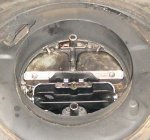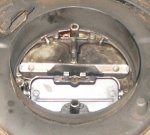Re: 1986 Chevy 350 Rochester problem
Hey jddenham
The best thing to do would be to disassemble the carb, clean it with carb cleaner and blow it dry and clean with compressed air. Lay all the parts out in the order they were removed.
see a generic exploded view here
http://www.carburetion.com/diags/4mv.jpg
There is a manual available on line here
http://www.tocmp.com/manuals/Carbs/Rochester/QJet/index.htm
you can read it from either HTML or PDF linkes provided.
When the vehicle is left sitting, the float bowl can drain through the lead plugs in the primary and secondary metering jet wells into the intake manifold. You can locate the wells when you remove the carburator and turn it over. The primary metering wells will be visible through a pair of irregular shaped holes between the primary throttle holes. The secondary well plugs are further back, between the secondaries. All are exposed to engine vacuum and if leaking, affect fuel mileage when the engine is running.
You will need to remove the base plate where the throttle plates are located. Use some spray carb cleaner and medium emery cloth to clean them. I've had good success coating them with epoxy or JBweld in the short term. They will eventually leak again.
A view of the bottom side of the carb is in figure at this link
http://www.tocmp.com/manuals/Carbs/Rochester/QJet/HTML/MCarbRoch1973_4M_0026.htm
If the accelerator pump is not giving a full shot when the float bowl is full, the likely cause,outside of a bad cup seal, is the pump discharge ball located under the pump plunger. It is held in place under a threaded plug retainer. It's main job is to prevent the syphon of fuel out of the pump well when at cruising speeds and keep air out of the pump discharge passage while the plunger is lifted in the well.
Dirt and erosion are the enemies of keeping the ball seated. Remove the ball and clean the seat with carb cleaner and blow out any liquid and dirt. install the old, smooth, clean ball and give it a light tap into the seat using a pin punch and hammer. install a new check ball, the retainer and put the rest back together. with any luck it will be as good as new.
The little check valve in the filter inlet is to prevent the fuel tank from syphoning in the event of vehicle rollover. The float bowl will drain through the carb bowl vent.
good luck 30 years ago I was fixing them in my sleep after a long day in the shop.























